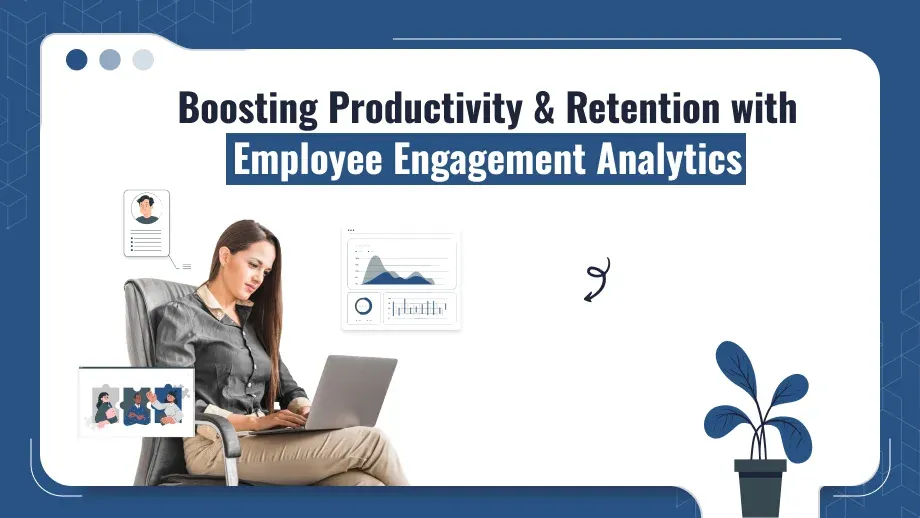
Why is employee engagement so vital for growth, and how does analytics transform it? While most companies understand that an engaged workforce is a necessity, few understand how to measure or improve it. employee engagement analytics gives leaders an opportunity to understand what gets employees motivated, identify the gaps, and tailor the approach to fill those gaps. This guide takes you on a deep dive into using data to understand, measure, and elevate employee engagement, focusing on metrics, tools, and practical applications.
Analytics of Employee Engagement and Their Impact on Business Success
Employee engagement analytics are measures beyond simple HR measures that create data-driven foundations of how people connect with their work, team, and company. Employees feel productivity, loyalty, and motivational values when they feel a connection to the organization when engaged. The employees then can make better contributions to company culture as well as customer satisfaction. Constant research has indicated that successful companies with higher engagement ratings tend to be more profitable; turnover rates are lower; and innovation capabilities are stronger.
For HR and leadership, understanding employee engagement strategies is essential for building a workplace where employees feel connected to both their individual goals and the company’s mission. This shows that engagement has a link to profitability. This is the reason why employee engagement metrics are important in being tracked. However, what is intricate about this is more than just data, and it’s emotional and psychological drivers with the employees. One example is productivity, retention, and even well-being which provides insightful value.
It’s one of the most crucial information sources for HR teams and managers regarding helping employees connect to the goals and the mission of the company. Let’s go into the key metrics in which employee engagement measurement helps a leader make more informed decisions.
Key Employee Engagement Metrics to Measure
Measuring employee engagement is challenging because it involves some quantitative and qualitative aspects, but some metrics will allow leaders to take a glimpse of the broader picture. Here are some core employee engagement metrics to consider in your employee engagement calendar:
Pulse Surveys
Pulse surveys are short, regular surveys that reflect the sentiment of employees. Unlike annual engagement surveys, pulse surveys provide continuous feedback and reveal trends over time. These surveys often cover a range of topics, including alignment with the company’s mission, satisfaction with job roles, and access to resources. For example, a typical pulse survey might ask:
- Do you feel supported by your team?
- How satisfied are you with the resources available to perform your role?
Conducting a monthly or quarterly pulse survey would enable HR teams to understand the mood within the organization and respond in real time by adjusting steps. Such running of such surveys can be facilitated on platforms like RecurPost to avoid getting distracted by things that the teams will experience when gathering and analyzing data.
Employee Net Promoter Score (NPS)
The eNPS, short for employee Net Promoter Score, is also a key engagement metric- that is how likely employees are likely to recommend the company to others. Using a scale of 0 to 10, a score is then categorized into three groups:
- Promoters (9-10): Highly engaged employees are likely to recommend the company.
- Passives (7-8): Moderately satisfied but not actively promoting the company.
- Detractors (0-6): Disengaged employees who may be at risk of leaving.
By monitoring eNPS, organizations can gain a quick overview of employee sentiment and loyalty, helping leaders understand general satisfaction levels.
Retention and Absenteeism Rates
Retention rates offer insight into employee loyalty, while absenteeism rates reveal disengagement or burnout. Frequent unplanned absences can indicate dissatisfaction or a lack of motivation, signaling a need for intervention. Tracking retention and absenteeism provides insight into the broader employee engagement process.
Work-life Balance and Wellness
Tracking work-life balance is critical in today’s work environment. Excessive overtime and poor balance can lead to disengagement and burnout. Monitoring work-life balance can reveal areas where the HR employee engagement strategy needs adjustment to maintain a healthy culture.
Workers want a balance between their personal and professional lives. Employee engagement projects that attract the main objective of work-life balance for employees have been known to decrease burnout and improve job satisfaction. Overworking can drive disengagement, so monitoring metrics around hours worked, overtime, and stress levels may help organizations manage workloads as reasonably as possible. Tools such as HRMS company software can help in tracking work hours and scheduling, thus workloads become more manageable.
Professional Development and Growth Opportunities
A strong engagement factor is the availability of career growth opportunities. Employees should feel that they are developing their careers and improving their expertise. The number of training programs, developmental workshops, and promotions participated in by employees provides information on the level of employee engagement in career development. High participation rates in professional development often correlate with higher engagement, as employees feel their growth is valued.
Would you like to maximize employee engagement analytics?
Make an impact today with our Employee Engagement Strategies!
Using Analytics Tools for Employee Engagement Measurement
To convert raw data into meaningful insights, companies rely on analytics tools specifically designed for engagement tracking. Below are some effective tools and methods for employee engagement analytics:
Data Dashboards
Data dashboards bring together employee engagement metrics into a single, accessible view. These dashboards display real-time data, allowing HR and leadership to track trends and engagement health at a glance. With customizable reports, dashboards enable leaders to see everything from survey results to productivity levels in one place, facilitating quick, informed decisions. Data dashboards are essential employee engagement platform tools for quick, informed decision-making.
Advanced Analytics Software
Software platforms like Qualtrics and Culture Amp offer advanced capabilities for engagement tracking. These tools merge engagement information with other key HR metrics, for example, productivity, performance, and retention. Merging the data into a single view allows the organization to get a good sense of engagement levels and more importantly, where to make improvements. Advanced tools also offer predictive modeling, helping companies forecast disengagement risks.
Predictive Analytics In Staff Engagement
Predictive analytics uses past data and can predict future trends in engagement. Companies can identify patterns with the help of AI and machine learning and can anticipate a lot of problems before they come up. Predictive models point to managers the teams or even the individual most at risk for possible disengagement; thus, proactive steps may be taken: perhaps more personalized coaching or adjustment of workload. The way engagement management is being transformed with predictive modeling from employee data analysis speaks to organizations’ competitive edge in retention and productivity.
HRMS Payroll Software for Streamlined Engagement Activities
HRMS payroll software in India, for example, allows organizations to integrate payroll, HR management, and engagement tracking. The integration of payroll attendance and engagement data will help to better streamline HR processes and have more time for strategic engagement initiatives.
Using platforms like virtual activities and engagement surveys can also keep remote teams connected. Their tools give scheduling for employee engagement activities so that a leader can easily plan events for the purpose of boosting morale and camaraderie.
Turning Data into Actionable Insights
Gather the data first. To enable real change, leaders must transform the insights into actions that make the employees engaged. How do they do this?
Data-driven Decision-making
Leaders have a panoramic view of engagement by viewing all the metrics. Pulse surveys, indicating dissatisfaction in some departments, can be used by the leaders to deploy resources to correct issues. Data-driven decision-making will ensure that only relevant and impactful changes are implemented.
Aligned Goals of an Individual with Company Goals
When the individual goals of the employees align with the company’s mission, they are more likely to be engaged. Employee engagement projects that align individual and company goals make employees see the importance of their work.
Creating Targeted Engagement Programs
Use insights from employee engagement measurement to create initiatives that cater to specific needs. For example, if engagement data shows that employees desire more flexibility, consider implementing remote work policies. For teams that may feel disconnected, virtual employee engagement activities like team-building sessions can foster stronger connections. Employee engagement survey tools make it easy to continuously measure program success, allowing for adjustments as needed.
Challenges in Implementing Employee Engagement Analytics
Despite the clear benefits, some challenges may arise when implementing employee engagement analytics. Here’s how to address them effectively:
Data Privacy Concerns
Employee data must be handled with care. There is a need to establish trust by transparently communicating how data will be used. Ensure that laws regarding data privacy are adhered to, and anonymized survey data should be applied as much as possible.
Subjectivity in Survey Responses
Surveys can sometimes reflect temporary sentiments rather than long-term engagement. To balance subjective responses, combine survey data with objective metrics like absenteeism and retention rates. This approach gives a clearer picture of engagement, ensuring decisions are based on both emotional and behavioral indicators.
Scaling Engagement Analytics Across Departments
In larger organizations, it may be challenging to scale engagement initiatives consistently. Start with pilot programs in a few departments, then expand based on feedback. Small and medium-sized companies can begin with basic employee engagement tool like eNPS and pulse surveys, gradually adding more sophisticated analytics as they grow.
Future Trends in Employee Engagement Analytics
Employee engagement analytics is an ever-evolving field. Some of the trends that are soon going to change the face of engagement are as follows:
AI-driven Personalization
AI is offering more personalized engagement strategies by reviewing data related to employee preferences, performance, and feedback. For example, AI-based tools can suggest customized career development paths based on skills and goals, which ultimately lead to greater engagement and job satisfaction.
Well-being and Mental Health Tracking
Today, it is being realized more than ever that mental health goes along with engagement. Therefore, tracking well-being metrics regarding stress levels, work-life balance, and burnout risk helps companies proactively engage with their workforce, just like the holistic shift seen in engagement, wherein psychological and emotional factors apart from productivity are considered.
Conclusion
Employee engagement analytics offers a roadmap to an engaged and productive workforce. Data will enable organizations to monitor the trends in engagement metrics, hence an organization that will ensure the employees are valued, thus contributing to the production of a bonding work environment. Pulse surveys, eNPS, and employee engagement survey tools enable leaders to act on valid insights and focus efforts on activities that work.
Integrate engagement activities into your calendar, and RecurPost is an effective tool that will give you several options to keep everyone’s engagement up throughout the year. Combine data-driven insights with people-centric strategies, and you will have a healthy and supportive workplace.





